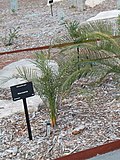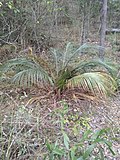- Macrozamia fraseri cone
- MacDonnell Ranges cycad ( M. macdonnellii ) in Cycad Gorge, Finke Gorge National Park, NT
| Burrawang Temporal range: [1] | |
|---|---|
 | |
| Macrozamia communis | |
| Scientific classification | |
| Kingdom: | Plantae |
| Clade: | Tracheophytes |
| Clade: | Gymnospermae |
| Division: | Cycadophyta |
| Class: | Cycadopsida |
| Order: | Cycadales |
| Family: | Zamiaceae |
| Subfamily: | Encephalartoideae |
| Tribe: | Encephalarteae |
| Subtribe: | Macrozamiinae |
| Genus: | Macrozamia Miq. |
| Type species | |
| Macrozamia spiralis (Salisbury) Miquel | |
Macrozamia is a genus of around forty cycad species endemic to Australia. Many parts of the plant have been utilised for food and material, most of which is toxic if not processed correctly.[ not in body ]














